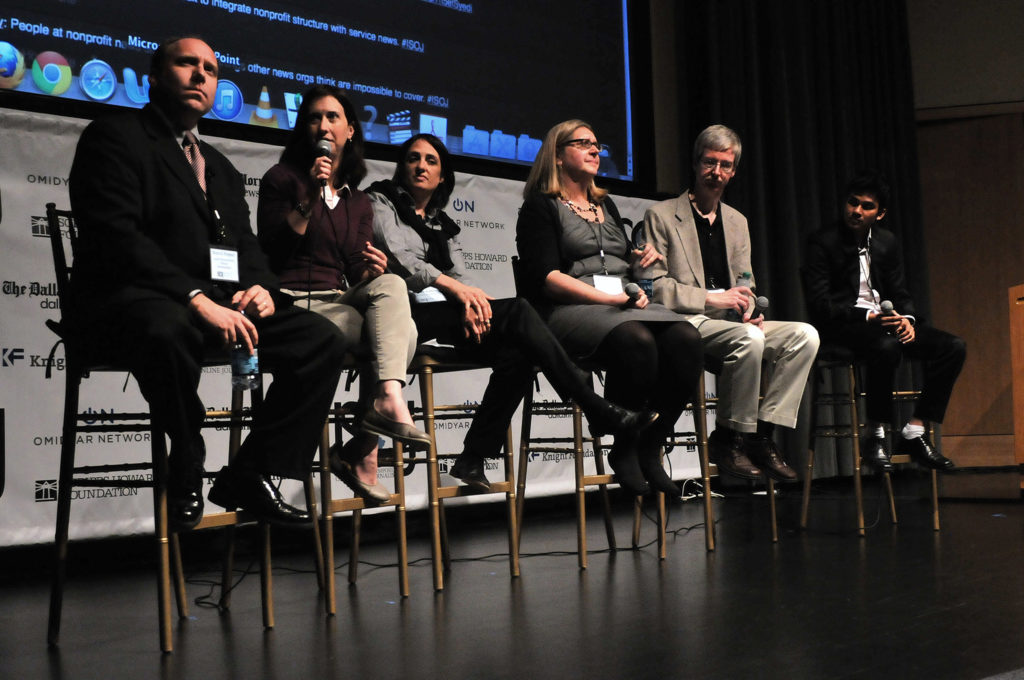May 28, 2013 | Citizen Journalism, Data Visualization, Engagement, Multimedia, Research, Social Media
ISOJ panelists discuss behind the scenes in the newsroom

The 14th annual International Symposium on Online Journalism closed its first day with a panel discussing how different news outlets are responding and evolving with advancements in technology. The panel consisted of journalists and academics who have researched news organizations’ attempts and progress in adapting to newsroom changes related to social media, digital media, and audience involvement and interaction.
The first panelist was Mohammad Yousuf from the University of Oklahoma since the first scheduled speaker, Elizabeth Hendrickson from the University of Tennessee, was unable to make it due to weather. Yousuf and David Craig researched the meaning of excellence in social-media journalism. After interviewing social-media reporters from a wide range of news outlets including the Associated Press, the British Broadcasting Company, The New York Times and Reuters, the researchers found five key elements when it comes to excellence in social media. Maintaining traditional accuracy standards in the news environment, sophistication in verification practices, sophistication in engagement, tailoring use of platforms, and adding value by being human all lead to successful social media reporting.
The second panelist was Cindy Royal from Texas State University – San Marcos. She researched the evolution of graphic and data visualization at the New York Times through its coverage of the 2008, 2010 and 2012 summer and winter Olympics.
“Programming and data techniques are rapidly influencing how organizations tell stories, but few currently have resources to deliver comprehensive media,” Royal said.
She looked at the Times’ graphic and data evolution through three topics –graphics, data and interactivity. Royal found that the 2008 and 2010 Olympics had more graphics than the 2012 Olympics, but 2012 had better quality graphics. She also found that data increased over the three Olympics and that interactivity grew vastly from 2008 to 2012 because of the emergence of social media and popular athletes on Twitter.
Royal ended with proposing potential academic programs that focused on data visualization, stating that there is need for it due to news delivery becoming more and more dependent on digital delivery.
The third panelist was Tamar Ashuri from Tel-Aviv University in Israel. Ashuri, along with Atara Frenkel-Faran from Sapir Academic College in Israel, researched the implementation of networked technologies in television-news organizations and the limited use of these technologies in Israeli television-news. They interviewed broadcast journalist working at Channel 2 and Channel 10 News in Israel about their perceptions of their professions and technology and how the implementation of network technologies affect their role as journalists.
Ashuri said they found that journalists want to cover news in an ethical aspect and be a sense of security to audiences in a social aspect. From an economical standpoint, Israeli journalists believe that if a program is unable to derive profit from new technologies, it will not be successful. Ashuri said that the traditional broadcast journalism model, which doesn’t use new technologies to their full capabilities, limits the industry.
The last speaker of the afternoon was Mark Poepsel from Loyola University in New Orleans. He researched the link between social and civic journalism and explained that civic journalism died sometime during the early 2000s because of audiences losing interest and their inability to have rational debates.
Poepsel studied a content management system in a small town in Kansas called Healthsite, where there’s an effort to reinvigorate public journalism and create a space for discourse, cultural change and education. Poepsel found that the website got the community involved in debate, which was reasonable but not critical. He also said that while Healthsite is not exactly providing cultural change, it has potential because people are getting involved.
He closed by stating that journalists should be advocates for education and mobile literacy so that audiences will be interested in discourse and cultural change.
ISOJ 2013: The News Business Q&A panel during the 14th International Symposium on Online Journalism from Knight Center on Vimeo.

